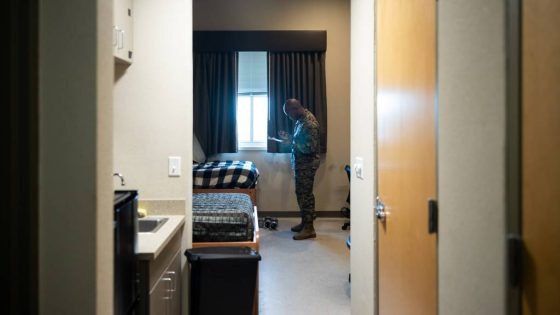WASHINGTON â Now that the Marine Corps is engaged in a sweeping effort to fix problems in its barracks buildings, Marine leaders have offered some explanations for how the barracks got to be substandard in the first place.
As the Marine Corpsâ budget chief sees it, one reason was years of spending more on weapons systems than on quality of life.
âFor too long, because we were taking risk in those types of initiatives in order to buy the weapons systems, they became more and more in disrepair,â Lt. Gen. James Adams, the deputy Marine commandant for programs and resources, said about the barracks at a panel discussion Wednesday at the Modern Day Marine conference in Washington.
As the land wars in Iraq and Afghanistan were ending, the Marine Corps began to prepare for the next big conflict, which it anticipated might be a faceoff with the powerful Chinese military in the Indo-Pacific. In 2020, then-Commandant Gen. David Berger launched the Force Design initiative to update the Corpsâ structure, training and platforms for that potential fight.
Meanwhile, the barracks were in bad shape.
A Government Accountability Office report in September 2023 found widespread problems, such as mold and water issues, in barracks across the military. Media reports in ensuing months highlighted dilapidated, moldy, vermin-infested and otherwise insufficient barracks in the Marine Corps.
Commandant Gen. Eric Smith, who took the helm of the Corps in summer 2023, has made improving the barracks a top priority.
As part of the Barracks 2030 initiative, the Marine Corps plans to consolidate Marines in the better buildings and demolish the worse ones, install professional barracks managers and spend more money on restoring barracks. In February, the Corps ordered each barracks room to be inspected âwall to wallâ so it could gather data about the problems and fix some of them immediately.
In response to a Marine Corps Times question about who was at fault for the previous underinvestment in barracks, Adams said, âI wouldnât say itâs a fault.â
Previously, the Corps had spent approximately $200 million a year toward maintaining and modernizing its living facilities, he said. That wasnât enough to stave off the degradation that happens to buildings over time.
But it was hard to justify receiving additional funds for barracks, especially as the force shrank as the military withdrew from Middle East wars, according to Adams.
âWe didnât have the data to say, âHow are we tracking the facilitiesâ condition in detail to defend more than $200 million a year for that?ââ Adams said. âBut we did have the data to say, âWe need this Force Design weapons system or this modernized vehicle or this modernized weapon platform.ââ
For fiscal year 2025, the Marine Corps is seeking from Congress $274 million for restoring barracks, a $65 million increase, and it has signaled via its budget wish list that it would like a further $230 million for that effort.
One major asked the panelists, who had a collective eight stars on their shoulders, if any Marine leaders would be held formally accountable for the problems with the barracks, which he characterized as âsystemicâ and âorganizational.â
âIâm the organizational failure that happened,â said Maj. Gen. David Maxwell, who has served as commander of Marine Corps Installations Command since July 2022.
Maxwell said he had been unable to communicate the state of the barracks to senior Marine leadership because he had been limited by having merely anecdotal data. That changed after his command launched the Corps-wide inspection, which determined approximately half of barracks rooms were only âpartially mission-capable,â meaning they had fallen short in at least one aspect of living standards.
Asked by Marine Corps Times why the Corps hadnât assembled the necessary data on the barracks earlier, Adams said, âWe didnât have the tools that we needed to actually collect up the data and to organize it in a way thatâs usable.â
Those advanced analytics tools include the big-data platform Advana, Adams said. The Defense Department has used that tool for some purposes since at least 2019, according to congressional testimony.
Irene Loewenson is a staff reporter for Marine Corps Times. She joined Military Times as an editorial fellow in August 2022. She is a graduate of Williams College, where she was the editor-in-chief of the student newspaper.
Source Agencies



